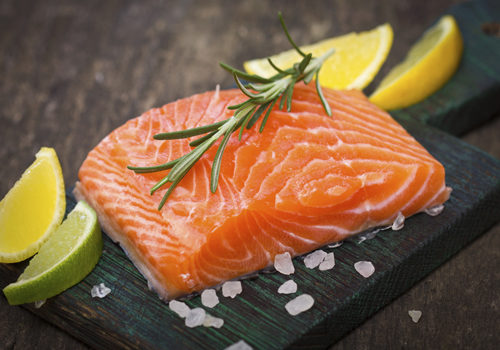Note: The views and opinions expressed here are those of the author(s) and contributor(s) and do not necessarily reflect those of the publisher and editors of WholeFoods Magazine.
It’s pretty common for people to ask, “How do I cut the fat from my diet?”
It’s far less common to ask, “How do I get more good fat into my diet?”
Nonetheless, the latter question is the smarter one.
Let me explain.
There are more misconceptions running around about “good” fat and “bad” fat than there are about witchcraft, hypnosis and the Kardashians combined. Expert opinions seem to be constantly in flux (first eggs were bad, then they were good, first butter was terrible, now margarine is). How much fat we should eat (and which kinds) are the subject of more debates than were seen during the entire primary season of the last election.
In this article, we’ll set the record straight on the subject of fat—what’s good and what’s not (and what’s surprisingly neutral). We’ll also tell you how to get more of the good stuff into your diet (and how to get less of the bad stuff).
But first, some definitions: Fat comes in three basic categories—saturated, polyunsaturated and monounsaturated. (There’s also a fourth kind of fat known as trans-fats, a kind of Franken-fat that we’ll deal with in a moment.)
Conventional advice is to dump all saturated and trans-fats and load up on the vegetable oils, omega-3’s and olive oil.
The conventional wisdom is anything but wise.
The conventional wisdom is actually right on trans-fats—at least the man-made kind. They should be banned from your diet, period. They’re found in virtually all packaged foods, cakes, crackers, and most margarines. Read the ingredients, and if it says “hydrogenated” or “partially hydrogenated” oil, it contains trans-fats, even if the label says “zero trans-fats”. (Why? Don’t ask. It’s a legal loophole, too long to explain here!). The exception to the zero tolerance rule on trans-fats is the one kind that’s “natural”—CLA. This trans-fat is made in the bodies of cows that graze on pasture (grass-fed) and actually has anti-cancer and anti-obesity activity.
Two other types of fat about which the conventional wisdom is right are monounsaturated fat (also known as omega-9’s) and omega-3’s.
The best-known source of monounsaturated fat is olive oil, but monounsaturated fat also found in nuts (macadamia nuts, almonds, pecans, cashews and pistachio nuts), avocados, and—wait for it—eggs and beef! (Would it surprise you to learn that the main fat in beef is monounsaturated, not saturated? And that the same thing is true for eggs?)
When it comes to omega-3s, there are three of them, two of which (EPA and DHA) are found primarily in cold-water fish like wild salmon, while the third (ALA) is found in plant sources like flaxseeds and flaxseed oil, as well chia seeds and chia oil.
Where the conventional advice goes wildly wrong is in the constant admonition to consume more vegetable oils. Here’s why: Vegetable oils like corn, safflower, sunflower and canola are simply loaded with omega-6’s (namely LA or linoleic acid). These oils are used in virtually every processed or packaged food made. Restaurants switched from the traditional lard to the supposedly “healthier” vegetable oils in the second half of the 20th century, and they now use these oils almost exclusively for frying and cooking. This is a problem for the following reason:
There’s nothing inherently wrong with omega-6 except for the fact that we get way too many of them.
Omega-3’s are the “parent” molecule for anti-inflammatory hormones in the body called Prostaglandin series 1 and series 3. Omega-6’s on the other hand, are the parent molecules for the inflammatory hormones (prostaglandins series 2). You actually need both types—inflammatory and anti-inflammatory—but the two hormone “factories” need to be in balance, like a seesaw, for optimal health. The best ratio of omega-6 to omega-3 consumption is 1:1, or thereabouts. However the typical western diet has a ratio of 20:1. That means we are “overfunding” our body’s inflammation army and “underfunding” the anti-inflammatory one. (No wonder inflammation is now at the core of every degenerative disease known to humans!)
So while it’s absolutely great to to get the full benefit of omega-3s, you’ll also want to cut back on your omega-6s, so your diet is closer to the ideal ratio of 1:1. Watch your intake of the usual suspects like corn oil, safflower oil, canola oil and soybean oil and follow the recommendations below to get more omega-3s in your diet.
The other place conventional wisdom is wildly out-of-date is the notion that saturated fat is bad for you. The truth is there are many saturated fats, and they have different effects in the body. Most of them are pretty neutral and many—like the lauric acid in coconut oil—are downright beneficial. In any case, several major meta-analyses done in the last decade have failed to show any causal role for saturated fat in heart disease. There’s no need to fear saturated fat. There is, however, a need to fear inflammatory fats!
Next month in part 2, I’ll give you 11 easy ways to get more good fat in your diet. Stay tuned!










